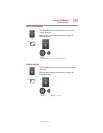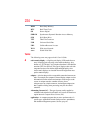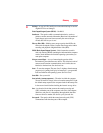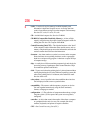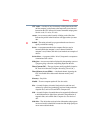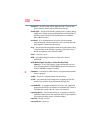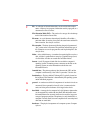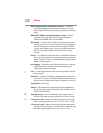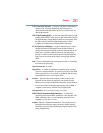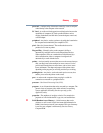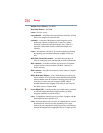
Glossary
227
CPU cache—A section of very fast memory residing between the CPU
and the computer’s main memory that temporarily stores data and
instructions the CPU will need to execute commands and programs.
See also cache, L1 cache, L2 cache.
cursor—An on-screen symbol (usually a flashing vertical line) that
indicates the position where characters will appear when you enter
data.
D
default—The setting selected by a program when the user does not
specify an alternative setting.
device—A component attached to the computer. Devices may be
external (outside the computer’s case) or internal (inside the
computer’s case). Printers, disk drives, and modems are examples of
devices.
device driver—A program (called a “driver”) that permits a computer to
communicate with a device.
dialog box—An on-screen window displayed by the operating system or
a program giving a direction or requesting input from the user.
Direct Current (DC)—The type of power usually supplied by batteries.
DC flows in one direction. Compare Alternating Current (AC).
Direct Memory Access (DMA)—A dedicated channel, bypassing the
CPU, that enables direct data transfer between memory and a
device.
directory—See folder.
disable—To turn a computer option off. See also enable.
disc—A round, flat piece of material, designed to be read from and
written to by optical (laser) technology, and used in the production
of optical discs, such as CDs and DVDs. Compare disk.
disk—A round, flat piece of material that can be magnetically influenced
to hold information in digital form, and used in the production of
magnetic disks, such as hard disks. Compare disc. See also hard
disk.
disk drive—The device that reads and writes information and programs
on external media or hard disk. It rotates the disk at high speed past
one or more read/write heads.



